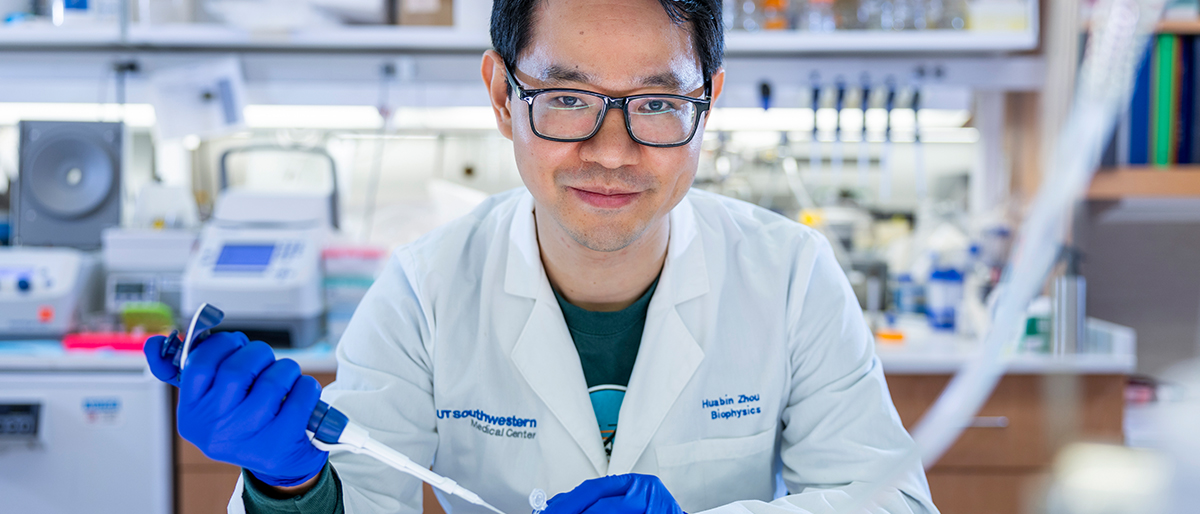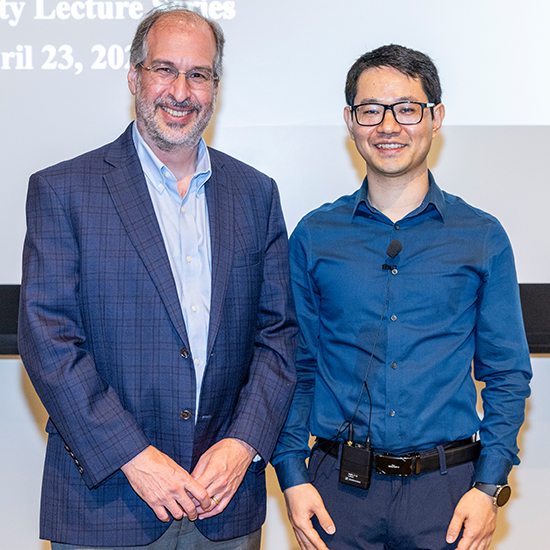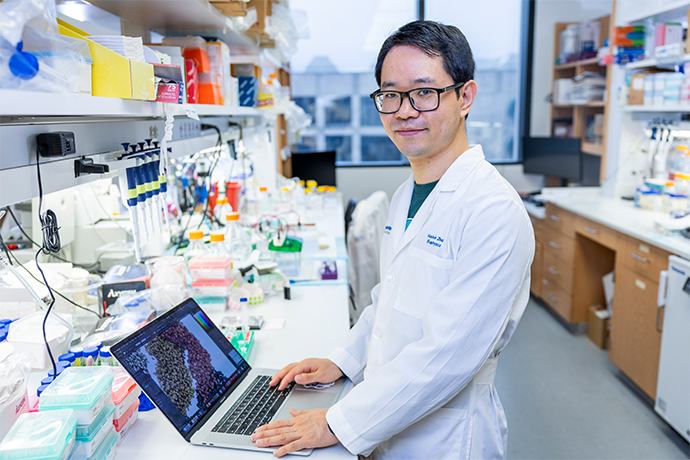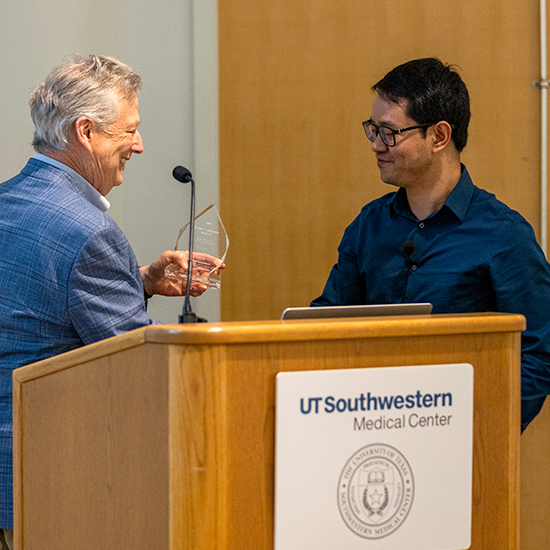Postdoc earns Brown-Goldstein Award for research on biomolecular condensates

When stretched out, the DNA in a single cell is about 2 meters long – approximately the height of a standard front door or the length of a queen-size mattress. But how this genetic molecule becomes compacted enough to fit inside a cell nucleus about 6 microns in diameter – less than a tenth of the width of a human hair – while still allowing access to cellular machinery that produces proteins has been a mystery.
Researchers believe cellular structures called biomolecular condensates are important contributors to this phenomenon. However, the mechanism by which condensates form in the nucleus and the internal organization of their contents has been unclear. The answer could help researchers understand what goes wrong in some diseases and develop new types of therapies.

Work over the last five years led by Huabin Zhou, Ph.D., a postdoctoral fellow in the laboratory of Michael Rosen, Ph.D., is helping answer these questions using advanced technology to visualize biomolecular condensates. This research recently earned Dr. Zhou the Brown-Goldstein Award for Excellence in Postdoctoral Research, given annually by the UT Southwestern Graduate School of Biomedical Sciences in honor of the contributions of UTSW Nobel Laureates Michael Brown, M.D., and Joseph Goldstein, M.D., to training future scientists.
Accompanied by a $6,500 prize and the opportunity to present a University Lecture, the award represents the highest recognition the Graduate School bestows on postdoctoral trainees. Dr. Zhou presented his lecture, “Illuminating the Hidden Structure of Chromatin,” on April 23.
“Huabin has been a true pioneer, bringing new methods into my lab and developing novel approaches to solve a difficult but very important problem,” said Dr. Rosen, Chair and Professor of Biophysics, an Investigator of the Howard Hughes Medical Institute, and Dr. Zhou’s mentor. “His efforts have led to a deep understanding of the phase separation of condensed DNA, spanning from nanometer to micrometer scales, and revealed new features of genome organization in cells.”
Dr. Zhou’s scientific discoveries, many of which rely on some of the most advanced microscopy tools available, have brought him far from his upbringing on a farm in a small, rural town in China. Although his farmer parents planned for him to follow in their footsteps, Dr. Zhou found himself fascinated in high school by cellular anatomy and the molecular machines cells use to carry out their vital functions. Driven by his curiosity, he earned an undergraduate degree in integrated life science from Lanzhou University in China, spending his last year studying chemical biology at the Max Planck Institute of Molecular Physiology in Germany.

Hoping to solve the world’s problems through science, he chose to pursue a Ph.D. at Peking University. There, he joined a large lab led by Luhua Lai, Ph.D., Professor of Chemistry and Molecular Engineering, where colleagues used computational and experimental approaches to answer biological questions. During his time at Peking University, Dr. Zhou began studying biomolecular condensates, dynamic networks of interacting proteins that segregate themselves within cells. This segregation happens without membranes through a process called phase separation, much like oil and water separate in a liquid mixture.
Dr. Zhou made several significant discoveries toward better understanding biomolecular condensates. These include learning how certain characteristics of some proteins’ intrinsically disordered regions – portions that don’t have a defined conformation – drive phase separation. He also found that the chemical properties of transcriptional repressors – proteins that inhibit gene activation – allow them to readily form condensates.
Hoping to build on these findings, Dr. Zhou joined the Rosen Lab for a postdoctoral fellowship in 2019. He was not only interested in studying with Dr. Rosen, an international expert on biomolecular condensates, but also in utilizing UT Southwestern’s Cryo-Electron Microscopy Facility, which houses high-tech instruments capable of imaging biomolecules at the atomic level at cryogenic temperatures (typically below -170 C).

Over the next three years, Dr. Zhou developed new protocols to image biomolecular condensates that had been reconstituted biochemically. Because typical methods to prepare biochemical samples for cryogenic freezing distorted the condensates, he came up with an approach that combines freezing under high pressure with another tool called focused ion beam milling, which shaves off minuscule portions of the condensates to access their insides. He also developed a new machine-learning-driven approach to identify structures of interest within these networks of proteins.
With this protocol, Dr. Zhou has made significant advances in elucidating the structures of biomolecular condensates composed of proteins and DNA, both when they are biochemically reconstituted in the test tube and in cells, revealing how the condensates form and attain their mechanical properties. These findings have been published in the Proceedings of the National Academy of Sciences and bioRxiv.
Dr. Zhou dreams of leading his own research team to have a deep understanding of how molecular machines work in cells and to eventually develop a digital model of every cell component. Why? Simulating the interactions of proteins, molecular machines, and genetic material under conditions that mimic healthy and diseased states could help researchers answer fundamental biological questions and further drug discovery.
“By developing this complete digital model, we will have the whole picture of how life works at the cellular level,” he said.
Endowed Titles
Dr. Brown, a Regental Professor, holds The W.A. (Monty) Moncrief Distinguished Chair in Cholesterol and Arteriosclerosis Research and the Paul J. Thomas Chair in Medicine.
Dr. Goldstein, a Regental Professor, holds the Julie and Louis A. Beecherl, Jr. Distinguished Chair in Biomedical Research and the Paul J. Thomas Chair in Medicine.
Dr. Rosen holds the Mar Nell and F. Andrew Bell Distinguished Chair in Biochemistry.

